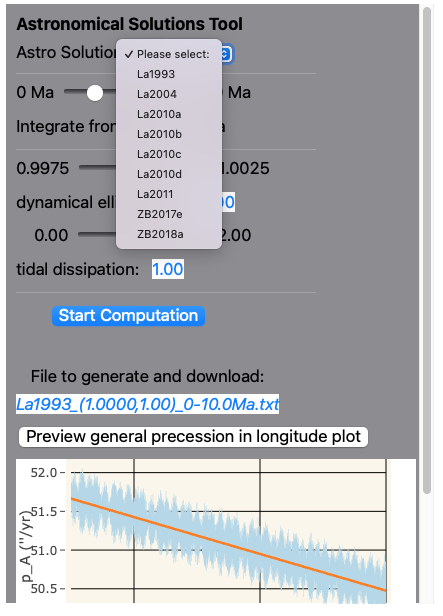This tool allows the calculation of astronomical orbital solutions with varying parameters for dynamical ellipticity and tidal dissipation.
The tool is available as a WebApp hosted at https://paloz.marum.de/AstroComputation/index.html.
Please cite as "AstroSolution, 2021, Heiko Pälike, [https://dx.doi.org/10.5281/zenodo.5736415]"
This package implements the integration of orbital (astronomical) solutions for Earth, based on the original implementation by Laskar et al. (1993) (retrieved 29 Nov 2021). In particular, it makes use of Keplerian elements, and calculates Earth's obliquity and climatic precession using Dopri8 and Adams integration methods. The calculation is performed by the client's machine by compiling the code as Wasm, using SwiftWasm, and the TokamakUI project to provide a SwiftUI like declarative Webpage definition.
Using the carton tool, the file can be compiled, packed and served through carton dev --release or used to re-generate the files in ./Bundle through carton bundle. The static (compiled) files in ./Bundle can be served locally, e.g. through python3 -m http.server --directory Bundle.
Orbital elements were published for the solutions of:
- Laskar, J., Joutel, F., Boudin, F.: 1993, Orbital, precessional and insolation quantities for the Earth from -20 Myr to + 10Myr, Astron. Astrophys. 270, 522 PDF.
- Laskar, J., Fienga, A., Gastineau, M., Manche, H.: 2011, La2010: A new orbital solution for the long-term motion of the Earth. Astron. Astrophys., Volume 532, A89, PDF. Datafiles for the solutions La2010a,b,c,d are available here: [http://vo.imcce.fr/insola/earth/online/earth/La2010/index.html].
IMPORTANT: Note that the reference frame for the La2010a,b,c,d solutions differs from those of La1993, and need to be rotated into the correct reference frame (done by the Webapp provided here.)
The following two orbital (Keplerian) elements were made available by the author (thank you!). They are not included in the supplementary materials or the homepage The citations to them are:
- Zeebe, R. E. Numerical Solutions for the orbital motion of the Solar System over the Past 100 Myr: Limits and new results. The Astronomical Journal, 2017. PDF
- Zeebe, R. E. and Lourens, L. J. Solar system chaos and the Paleocene-Eocene boundary age constrained by geology and astronomy. Science, [10.1126/science.aax0612], 2019. (PDF) (Supplement)
IMPORTANT: Note that the reference frame for the ZB2017e and ZB2018a solutions differs from those of La1993, and need to be rotated into the correct reference frame (done by the WebApp provided here.)
For the solution La2004 no orbital elements were published openly, nor made available by request to the author, so no further computation of different tidal dissipation and dynamical ellipticity models is possible here. A&A 428, 261-285 (2004), DOI: 10.1051/0004-6361:20041335 Laskar, J., Robutel, P., Joutel, F., Gastineau, M., Correia, A.C.M., Levrard, B.: 2004, A long term numerical solution for the insolation quantities of the Earth.
Likewise, for the orbital solution La2011, referenced as (Strong chaos induced by close encounters with Ceres and Vesta”, by J. Laskar, M. Gastineau, J.-B. Delisle, A. Farrès, and A. Fienga. Astronomy & Astrophysics, 2011, vol. 532, L4.)[https://dx.doi.org/10.1051/0004-6361/201117504], no data were formally published, but can be accessed via (Astrochron). Both of these solutions can thus unfortunately not be used for additional reproducible research.
Heiko Pälike, 29. November 2021
